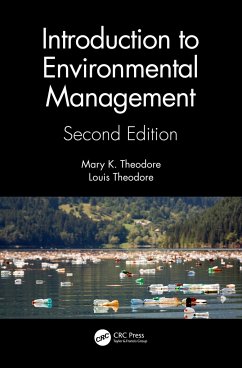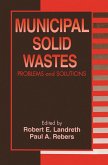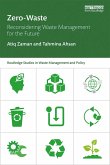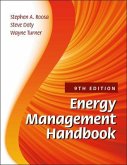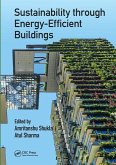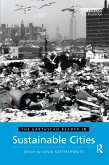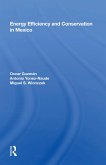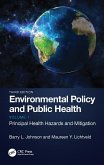Mary K. Theodore (Manhattan College, Riverdale, New York, USA), Louis Theodore (Manhattan College, New York, USA)
Introduction to Environmental Management
Mary K. Theodore (Manhattan College, Riverdale, New York, USA), Louis Theodore (Manhattan College, New York, USA)
Introduction to Environmental Management
- Gebundenes Buch
- Merkliste
- Auf die Merkliste
- Bewerten Bewerten
- Teilen
- Produkt teilen
- Produkterinnerung
- Produkterinnerung
Written at a level that is accessible to students in all disciplines, Introduction to Environmental Management, Second Edition translates complex environmental issues into practical and understandable terms.
Andere Kunden interessierten sich auch für
![Municipal Solid Wastes Municipal Solid Wastes]() Robert E. LandrethMunicipal Solid Wastes62,99 €
Robert E. LandrethMunicipal Solid Wastes62,99 €![Zero-Waste Zero-Waste]() Atiq Zaman (Australia Curtin University)Zero-Waste48,99 €
Atiq Zaman (Australia Curtin University)Zero-Waste48,99 €![Energy Management Handbook Energy Management Handbook]() Stephen A. RoosaEnergy Management Handbook287,99 €
Stephen A. RoosaEnergy Management Handbook287,99 €![Sustainability through Energy-Efficient Buildings Sustainability through Energy-Efficient Buildings]() Sustainability through Energy-Efficient Buildings49,99 €
Sustainability through Energy-Efficient Buildings49,99 €![The Earthscan Reader in Sustainable Cities The Earthscan Reader in Sustainable Cities]() The Earthscan Reader in Sustainable Cities65,99 €
The Earthscan Reader in Sustainable Cities65,99 €![Energy Efficiency and Conservation in Mexico Energy Efficiency and Conservation in Mexico]() Oscar GuzmanEnergy Efficiency and Conservation in Mexico45,99 €
Oscar GuzmanEnergy Efficiency and Conservation in Mexico45,99 €![Environmental Policy and Public Health Environmental Policy and Public Health]() Barry L. Johnson (USA Emory University)Environmental Policy and Public Health126,99 €
Barry L. Johnson (USA Emory University)Environmental Policy and Public Health126,99 €-
-
-
Written at a level that is accessible to students in all disciplines, Introduction to Environmental Management, Second Edition translates complex environmental issues into practical and understandable terms.
Hinweis: Dieser Artikel kann nur an eine deutsche Lieferadresse ausgeliefert werden.
Hinweis: Dieser Artikel kann nur an eine deutsche Lieferadresse ausgeliefert werden.
Produktdetails
- Produktdetails
- Verlag: Taylor & Francis Ltd
- 2 ed
- Seitenzahl: 526
- Erscheinungstermin: 20. Mai 2021
- Englisch
- Abmessung: 254mm x 178mm x 36mm
- Gewicht: 1226g
- ISBN-13: 9780367758103
- ISBN-10: 0367758105
- Artikelnr.: 61945878
- Herstellerkennzeichnung
- Libri GmbH
- Europaallee 1
- 36244 Bad Hersfeld
- gpsr@libri.de
- Verlag: Taylor & Francis Ltd
- 2 ed
- Seitenzahl: 526
- Erscheinungstermin: 20. Mai 2021
- Englisch
- Abmessung: 254mm x 178mm x 36mm
- Gewicht: 1226g
- ISBN-13: 9780367758103
- ISBN-10: 0367758105
- Artikelnr.: 61945878
- Herstellerkennzeichnung
- Libri GmbH
- Europaallee 1
- 36244 Bad Hersfeld
- gpsr@libri.de
Mary K. Theodore - the daughter of immigrant parents from Ireland - received her BA degree in English from Manhattan College and MA in Applied Linguistics from Queens College. She is a member of the International English Honor Society of Sigma Tau Delta and honor society Epsilon Sigma Pi. Ms. Theodore is presently the president of TheodoreTutorials, a company that specializes in providing training needs to industry, government, and academia. She is the author of the chapter entitled "Domestic Solutions" in the Handbook of Environmental Management and Technology (Wiley-Interscience, 1993; the only nontechnical chapter in the handbook); coauthor of the unpublished, but copyrighted, work "A Citizen's Guide to Pollution Prevention"; and, coauthor of Major Environmental Issues Facing the 21st Century (Prentice-Hall, 1996) and "introduction to Environmental Management" (CRC Press/Taylor & Francis Group, 2009). The latter text effectively integrated the concept of "sustainable growth without environmental degradation" at both the industrial and domestic levels. Ms. Theodore is also a contributor to Luna, a collection of poetry, prose, and short stories. Ms. Theodore is currently an adjunct faculty member at the New York Institute of Technology (NYIT). Since marriage and the birth of her first child, Ms. Theodore has devoted a significant part of her life to help solve the environmental problems facing society from a domestic point of view. A proactive environmentalist with no ties to any of the environmental organizations in vogue today, she has also lectured in this area. She was recently involved with the development of a nontechnical environmental calendar that serves as a consumer and youth outreach product. Ms. Theodore resides in East Williston, Long Island, New York, with her husband of 53 years. Louis Theodore - the son of immigrant parents from Greece - is a retired professor of chemical engineering at Manhattan College, Riverdale, New York. Born and raised in Hell's Kitchen, he received his MChE and EngScD from New York University and his BChE from The Cooper Union. Over the past 60 years, Dr. Theodore has been a successful educator, researcher, professional innovator, and communicator in the field of engineering. He has taught academic courses in environmental management, hazardous waste incineration, accident and emergency management, pollution prevention, air pollution control, and environmental health and hazard risk assessment. Dr. Theodore is an internationally recognized lecturer who has provided nearly 200 courses to industry, government, and technical associations; he has served as an after-dinner or luncheon speaker on numerous occasions; and he has appeared on television as a guest commentator and a news spokesperson. He has developed training materials and has served as the principal moderator/lecturer for U.S. Environmental Protection Agency (USEPA) courses. He has also served as a consultant to several industrial companies in the field of environmental management, and is presently a consultant/expert witness for the USEPA and the U.S. Department of Justice. Dr. Theodore has written 121 text/reference books plus "Basketball Coaching 101". He is also the cofounder of Theodore Tutorials, a company specializing in providing training needs to industry, government, and academia; included in this TheodoreTutorials series of 21 texts are four tutorials concerned with the professional engineer's (PE) exam. Dr. Theodore is the recipient of the prestigious Ripperton award from the International Air and Waste Management Association (AWMA) that is "presented to an outstanding educator who through example, dedication, and innovation has so inspired students to achieve excellence in their professional endeavors." Earlier, he was the recipient of the American Society of Engineering Education AT&T Foundation award for "excellence in the instruction of engineering students." Dr. Theodore was also honored at Madison Square Garden in 2008 for his contributions to basketball and the youth of America. Dr. Theodore is a member of Phi Lambda Upsilon, Sigma Xi, Tau Beta Pi, American Chemical Society, American Society of Engineering Education, Royal Hellenic Society, and the International Air and Waste Management Association. He is also certified to referee scholastic basketball games through his membership in the International Association of Approved Basketball Officials. He previously served on a Presidential Crime Commission and proved invited testimony. His column "AS I SEE IT" - drawn from www. Theodorenewsletter.com - addresses social, economic, political, technical, and sports issues, and is a monthly feature of several Long Island newspapers, plus the Queens Gazette.
PART I: Overview
Chapter 1
Introduction to Environmental Issues
Chapter 2
Environmental Regulations
Chapter 3
International Environmental Regulations
Chapter 4
ISO 14000
Chapter 5
Multimedia Concerns
Chapter 6
Classification and Sources of Pollutants
Chapter 7
Effects of Pollutants
Chapter 8
Measurement Methods
PART II: Air
Chapter 9
Air Pollution Control Equipment
Chapter 10
Atmospheric Dispersion Modeling
Chapter 11
Climate Change and Global Warming
Chapter 12
Indoor Air Quality
Chapter 13
Vapor Intrusion
Chapter 14
Air Toxics
PART III: Water
Chapter 15
Water Chemistry
Chapter 16
Safe Drinking Water
Chapter 17
Desalination
Chapter 18
Municipal Wastewater Treatment
Chapter 19
Industrial Wastewater Management
Chapter 20
Dispersion Modeling in Water Systems
Chapter 21
Water Conservation
Chapter 22
Water Toxics
PART IV: Solid Waste
Chapter 23
Municipal Waste Management
Chapter 24
Industrial Waste Management
Chapter 25
Hospital Waste Management
Chapter 26
Nuclear Waste Management
Chapter 27
Superfund
Chapter 28
Asbestos
Chapter 29
Metals
PART V: Pollution Prevention
Chapter 30
The Pollution Prevention Concept
Chapter 31
Pollution Prevention Applications
Chapter 32
Sustainability
Chapter 33
Green Chemistry and Green Engineering
Chapter 34
Industrial Ecology
Chapter 35
Architecture in the Environment
PART VI: Environmental Risk
Chapter 36
Introduction to Environmental Risk Assessment
Chapter 37
Health Risk Assessment
Chapter 38
Hazard Risk Assessment
Chapter 39
Non-technical Risk
Chapter 40
Public Perception of Risk
Chapter 41
Risk Communication
PART VII: Energy Considerations
Chapter 42
Energy Resources
Chapter 43
Energy Conservation
Chapter 44
Energy Conservation Applications
Chapter 45
Heat Transfer and Heat Exchanger Principles
Chapter 46
Thermodynamics: Energy, Entropy, Exergy
Chapter 47
Energy-Environmental Interactions
PART VIII: Other Areas of Interrest
Chapter 48
The EPA Dilemma
Chapter 49
Electromagnetic Fields
Chapter 50
Noise Pollution
Chapter 51
Used Oil
Chapter 52
Underground Storage Tanks
Chapter 53
Environmental Audits
Chapter 54
Economics
Chapter 55
Nanotechnology Concerns
Chapter 56
Acid Rain
Chapter 57
Training Options
Chapter 58
Legal Issues
Chapter 59
Environmental Ethical Considerations
Chapter 60
Environmental Justice
Chapter 1
Introduction to Environmental Issues
Chapter 2
Environmental Regulations
Chapter 3
International Environmental Regulations
Chapter 4
ISO 14000
Chapter 5
Multimedia Concerns
Chapter 6
Classification and Sources of Pollutants
Chapter 7
Effects of Pollutants
Chapter 8
Measurement Methods
PART II: Air
Chapter 9
Air Pollution Control Equipment
Chapter 10
Atmospheric Dispersion Modeling
Chapter 11
Climate Change and Global Warming
Chapter 12
Indoor Air Quality
Chapter 13
Vapor Intrusion
Chapter 14
Air Toxics
PART III: Water
Chapter 15
Water Chemistry
Chapter 16
Safe Drinking Water
Chapter 17
Desalination
Chapter 18
Municipal Wastewater Treatment
Chapter 19
Industrial Wastewater Management
Chapter 20
Dispersion Modeling in Water Systems
Chapter 21
Water Conservation
Chapter 22
Water Toxics
PART IV: Solid Waste
Chapter 23
Municipal Waste Management
Chapter 24
Industrial Waste Management
Chapter 25
Hospital Waste Management
Chapter 26
Nuclear Waste Management
Chapter 27
Superfund
Chapter 28
Asbestos
Chapter 29
Metals
PART V: Pollution Prevention
Chapter 30
The Pollution Prevention Concept
Chapter 31
Pollution Prevention Applications
Chapter 32
Sustainability
Chapter 33
Green Chemistry and Green Engineering
Chapter 34
Industrial Ecology
Chapter 35
Architecture in the Environment
PART VI: Environmental Risk
Chapter 36
Introduction to Environmental Risk Assessment
Chapter 37
Health Risk Assessment
Chapter 38
Hazard Risk Assessment
Chapter 39
Non-technical Risk
Chapter 40
Public Perception of Risk
Chapter 41
Risk Communication
PART VII: Energy Considerations
Chapter 42
Energy Resources
Chapter 43
Energy Conservation
Chapter 44
Energy Conservation Applications
Chapter 45
Heat Transfer and Heat Exchanger Principles
Chapter 46
Thermodynamics: Energy, Entropy, Exergy
Chapter 47
Energy-Environmental Interactions
PART VIII: Other Areas of Interrest
Chapter 48
The EPA Dilemma
Chapter 49
Electromagnetic Fields
Chapter 50
Noise Pollution
Chapter 51
Used Oil
Chapter 52
Underground Storage Tanks
Chapter 53
Environmental Audits
Chapter 54
Economics
Chapter 55
Nanotechnology Concerns
Chapter 56
Acid Rain
Chapter 57
Training Options
Chapter 58
Legal Issues
Chapter 59
Environmental Ethical Considerations
Chapter 60
Environmental Justice
PART I: Overview
Chapter 1
Introduction to Environmental Issues
Chapter 2
Environmental Regulations
Chapter 3
International Environmental Regulations
Chapter 4
ISO 14000
Chapter 5
Multimedia Concerns
Chapter 6
Classification and Sources of Pollutants
Chapter 7
Effects of Pollutants
Chapter 8
Measurement Methods
PART II: Air
Chapter 9
Air Pollution Control Equipment
Chapter 10
Atmospheric Dispersion Modeling
Chapter 11
Climate Change and Global Warming
Chapter 12
Indoor Air Quality
Chapter 13
Vapor Intrusion
Chapter 14
Air Toxics
PART III: Water
Chapter 15
Water Chemistry
Chapter 16
Safe Drinking Water
Chapter 17
Desalination
Chapter 18
Municipal Wastewater Treatment
Chapter 19
Industrial Wastewater Management
Chapter 20
Dispersion Modeling in Water Systems
Chapter 21
Water Conservation
Chapter 22
Water Toxics
PART IV: Solid Waste
Chapter 23
Municipal Waste Management
Chapter 24
Industrial Waste Management
Chapter 25
Hospital Waste Management
Chapter 26
Nuclear Waste Management
Chapter 27
Superfund
Chapter 28
Asbestos
Chapter 29
Metals
PART V: Pollution Prevention
Chapter 30
The Pollution Prevention Concept
Chapter 31
Pollution Prevention Applications
Chapter 32
Sustainability
Chapter 33
Green Chemistry and Green Engineering
Chapter 34
Industrial Ecology
Chapter 35
Architecture in the Environment
PART VI: Environmental Risk
Chapter 36
Introduction to Environmental Risk Assessment
Chapter 37
Health Risk Assessment
Chapter 38
Hazard Risk Assessment
Chapter 39
Non-technical Risk
Chapter 40
Public Perception of Risk
Chapter 41
Risk Communication
PART VII: Energy Considerations
Chapter 42
Energy Resources
Chapter 43
Energy Conservation
Chapter 44
Energy Conservation Applications
Chapter 45
Heat Transfer and Heat Exchanger Principles
Chapter 46
Thermodynamics: Energy, Entropy, Exergy
Chapter 47
Energy-Environmental Interactions
PART VIII: Other Areas of Interrest
Chapter 48
The EPA Dilemma
Chapter 49
Electromagnetic Fields
Chapter 50
Noise Pollution
Chapter 51
Used Oil
Chapter 52
Underground Storage Tanks
Chapter 53
Environmental Audits
Chapter 54
Economics
Chapter 55
Nanotechnology Concerns
Chapter 56
Acid Rain
Chapter 57
Training Options
Chapter 58
Legal Issues
Chapter 59
Environmental Ethical Considerations
Chapter 60
Environmental Justice
Chapter 1
Introduction to Environmental Issues
Chapter 2
Environmental Regulations
Chapter 3
International Environmental Regulations
Chapter 4
ISO 14000
Chapter 5
Multimedia Concerns
Chapter 6
Classification and Sources of Pollutants
Chapter 7
Effects of Pollutants
Chapter 8
Measurement Methods
PART II: Air
Chapter 9
Air Pollution Control Equipment
Chapter 10
Atmospheric Dispersion Modeling
Chapter 11
Climate Change and Global Warming
Chapter 12
Indoor Air Quality
Chapter 13
Vapor Intrusion
Chapter 14
Air Toxics
PART III: Water
Chapter 15
Water Chemistry
Chapter 16
Safe Drinking Water
Chapter 17
Desalination
Chapter 18
Municipal Wastewater Treatment
Chapter 19
Industrial Wastewater Management
Chapter 20
Dispersion Modeling in Water Systems
Chapter 21
Water Conservation
Chapter 22
Water Toxics
PART IV: Solid Waste
Chapter 23
Municipal Waste Management
Chapter 24
Industrial Waste Management
Chapter 25
Hospital Waste Management
Chapter 26
Nuclear Waste Management
Chapter 27
Superfund
Chapter 28
Asbestos
Chapter 29
Metals
PART V: Pollution Prevention
Chapter 30
The Pollution Prevention Concept
Chapter 31
Pollution Prevention Applications
Chapter 32
Sustainability
Chapter 33
Green Chemistry and Green Engineering
Chapter 34
Industrial Ecology
Chapter 35
Architecture in the Environment
PART VI: Environmental Risk
Chapter 36
Introduction to Environmental Risk Assessment
Chapter 37
Health Risk Assessment
Chapter 38
Hazard Risk Assessment
Chapter 39
Non-technical Risk
Chapter 40
Public Perception of Risk
Chapter 41
Risk Communication
PART VII: Energy Considerations
Chapter 42
Energy Resources
Chapter 43
Energy Conservation
Chapter 44
Energy Conservation Applications
Chapter 45
Heat Transfer and Heat Exchanger Principles
Chapter 46
Thermodynamics: Energy, Entropy, Exergy
Chapter 47
Energy-Environmental Interactions
PART VIII: Other Areas of Interrest
Chapter 48
The EPA Dilemma
Chapter 49
Electromagnetic Fields
Chapter 50
Noise Pollution
Chapter 51
Used Oil
Chapter 52
Underground Storage Tanks
Chapter 53
Environmental Audits
Chapter 54
Economics
Chapter 55
Nanotechnology Concerns
Chapter 56
Acid Rain
Chapter 57
Training Options
Chapter 58
Legal Issues
Chapter 59
Environmental Ethical Considerations
Chapter 60
Environmental Justice

